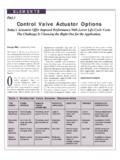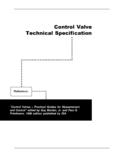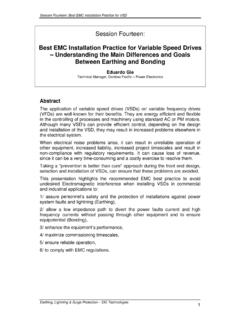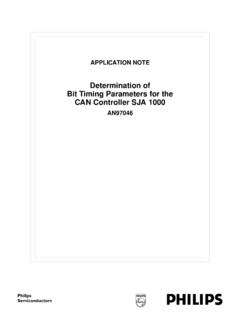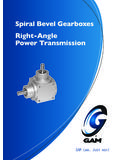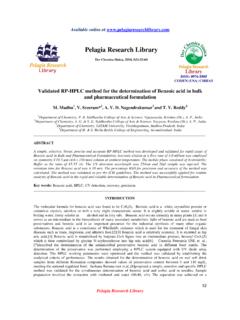Transcription of Spot and Composite Sampling for BTU Analysis …
1 Spot and Composite Sampling for BTU AnalysisDetermination and Natural Gas Physical PropertiesDavid J. Fish, Welker, need to be able to take a representative sample of a hydrocarbon product is necessary to ensure proper accounting for transactions and efficient product processing. The various Sampling methods that are available and the options and limitations of these methods are investigated; the most appropriate equipment to use; the reasons for its use and correct installation of the equipment are also amount of hydrocarbon product that is transported between producer, processor, distributor and user is significant. To be able to verify the exact composition of the product is important from an economic and product treatment standpoint. A small percentage savings made by correctly determining composition will quickly recoup the investment made in the purchase of a system designed to obtain an optimum sample. In addition, if the best Sampling procedures are followed, the potential for disputes between supplier and customer will be greatly reduced.
2 The importance of properly determining hydrocarbon gas composition benefits all parties involved and will achieve greater significance as this resource becomes more expensive and plays a larger role in our energy needs the Gas Processors Association publication GPA 2166-05, "The objective of the listed Sampling procedures is to obtain a representative sample of the gas phase portion of the flowing stream under investigation. Any subsequent Analysis of the sample regardless of the test, is inaccurate unless a representative sample is obtained. And, from ISO-10715, a representative sample is, A sample having the same composition as the material sampled, when the latter is considered as a homogeneous whole. API offers a similar statement in the latest revision, a representative sample is compositionally identical or as near to identical as possible, to the sample source stream , as does ASTM 5287-08. These standards are the most common referenced on Gas Sampling procedures, along with the AGA Gas Measurement Manual, Part No.
3 11, Section Sampling is fundamental to the correct determination of the product composition. In a majority of cases, the sample is also the source for the determination of the specific gravity of the gas. This figure is a critical component of the flow formula, from which we derive the product quantity. An error in Sampling effects both quality and quantity, and ultimately, profitability. Most current Gas Chromatographs boast an accuracy level of of a BTU, but that should not be the comfort zone for the measurement department. A faulty Sampling method or improperly installed and maintained equipment may alter the BTU content of the flowing stream by 25+ BTU. While the accuracy of the GC may be considered as a given, the properly executed technique for taking the sample is certainly not a SAMPLINGN atural Gas Sampling has been performed for years with techniques handed down from generation to generation. Most of the methods are not sufficient to meet today's requirements of accuracy and repeatability; however, standards have been developed to reach toward these demands.
4 The most widely known standards are GPA-2166-05 and ISO-10715. API has produced a revised API , which was published in June, 2001. It has been updated and revised in 2006. This new standard has already generated significant interest in proper Sampling techniques, due to a large volume of data produced during the revision maintenance of all Sampling equipment is vital to the operations of all Sampling methods. A review of relative Sampling standards and the manufacturer s operation, installation and maintenance manuals, is an important step in the total accurate Sampling process. Dirty or poorly maintained Sampling apparatus will adversely affect the final results and profitability of the gas company s COMPONENTS Sampling can be accomplished by primarily three techniques; spot, continuous Composite or continuous on-line Sampling systems. The various components of a Sampling system deserve individual consideration, before the various Sampling procedures are investigated.
5 All components should be compatible with the fluid being - On-line Analysis should use regulators to reduce the pressure to the analyzer. They will reduce the gas volume to the sampler, thus minimizing the time delay between the sample point, via the regulator, to the analyzer. This will lessen any negative effect on the gas sample by ambient type or probe regulators are preferable as they will be able to reduce the sample pressure in the flowing stream enabling a minimization of the Joule-Thompson effect created by the pressure drop. The ambient temperature of the pipeline gas is transmitted via thermal fins, to offset the cooling effect. The design purpose of the probe regulator is to not create liquids where liquids do not exist. They were designed for rich, dry gas systems. All aspects of the regulator systems should consider Hydrocarbon Dew Point impact on the process and be temperature conditioned to prevent those issues as much as possible.
6 Not all installations will require attention, but the ones which don t now days, will be few and far between. Wet gas systems present a new Sampling - If shut-off/isolation valves present a restriction that causes a pressure drop, it is possible that condensation could occur. Large orifice valves should be used, as restrictive valve paths can cause fractionization of the sampled gas. API addresses these porting issues for valves used in the Sampling used with a collection cylinder it is important that there are no leaks from the gland. Light ends will be the first to leak off, thereby causing the sample to be overrepresented with heavy ends. It is wise to use valves with soft seals to give a positive shut-off. Filters - For on-line analyzers, it is sensible to install a filter. Proper selection of the filter flow capacity and the particle size capacity should be encouraged.
7 A filter that is too small or does not have a sufficient drip pot capacity for gases that have entrained water, is a recipe for high maintenance and off spec Analysis . It is prudent to invest in a reasonable valves - Regulators should have a relief valve installed downstream, if the equipment downstream is not able to withstand full upstream pressure. Regulators will not always give a guaranteed shut-off and their lock-up pressure will climb to a dangerous level should there be failure to attain a good shut-off such as seal damage, diaphragm damage or impurity build-up on working parts and sensing lines. Pipework - Should be as short and as small a diameter as possible. This will assist in minimizing the time delay from sample point to the analyzer or cylinder. It will also help maintain the sample integrity. When used with on-line analyzers, sample delivery lines should slope upward from the probe to the analyzer to prevent condensation and impurities entering the analyzer.
8 Lead lines to continuous samplers should slope back and drain towards the Elements There is sufficient evidence to show that heating all components of a Sampling system is a prudent step in having a reliable and accurate Sampling system. The hydrocarbon dew point of a natural gas stream is a critical issue in obtaining a representative gas sample. API spends considerable time on this issue of heating and Hydrocarbon Dew Point, as does GPA - The correct placement is at the top of the pipe, into the center one third or at least 200 mm (8 inches) for larger diameter pipes; in an area of minimum turbulence, that is, away from headers, bends, valves, etc. Turbulence will stir up the contaminates that usually reside at the bottom of the pipeline and are therefore not normally part of the gas stream. By having the probe at a point of turbulence these contaminates will be taken into the sample, giving a sample that is not representative. The key is to have the probe in the center of the line in the correct spot (positive velocity/no turbulence) with a proper valve on the outlet.
9 Field applications have shown that mounting the probe on the top of the pipeline is the preferred location. Side, lower or bottom mounts can easily encourage free liquids (if present) to migrate into the sample Pump - These pumps are, of course, needed to extract the sample from the line and transfer the sample to the analyzer or collection cylinder. They should have the capability to be able to extract the sample under flowing conditions, maintain a consistent discrete size of sample, take a fresh purged sample every time and have the ability to be controlled by a timer or proportional-to-flow controller. This forms the heart of the continuous gas Sampling system. If the pump or sampler is unable to perform all these functions, a representative sample will not be taken and the Sampling exercise will be can be either pneumatic or electric. The safety requirements of the electrical components such as motors and solenoid valves and the environmental protection rating, dictate careful selection and compliance with applicable codes.
10 The selection options may well be limited if electrical components have requirements which are incompatible with the use of standard components elsewhere in the Cylinders - Used for the collection of gases and light liquid hydrocarbons, sometimes called "sample bombs". The cylinders come in three forms; one is a plain single cavity cylinder with a valve at each end, one is a single cavity, single fill cylinder with a removable inner bladder and valves at each end, and the third is a Constant Pressure Sample Cylinder, which takes the form of a closed end cylinder with an internal piston. Before using this cylinder, one side is pressurized forcing the piston to the sample end. When the sample is taken, the product is then collected against that back pressure and stored at whatever pressure is pre-charged at the back of the piston. Using the Constant Pressure Cylinder the sample can be collected at a pressure above the vapor pressure of the light ends.
